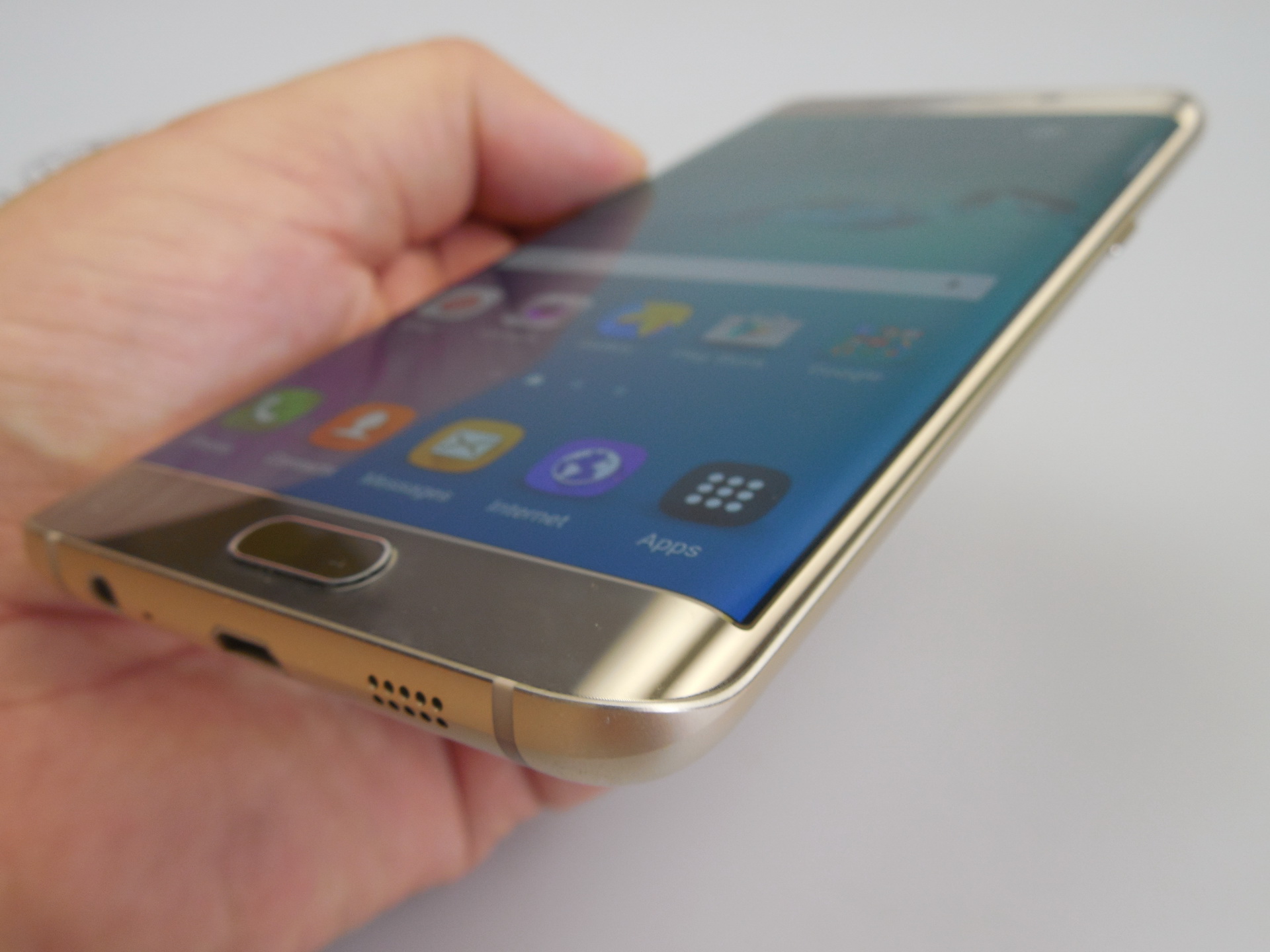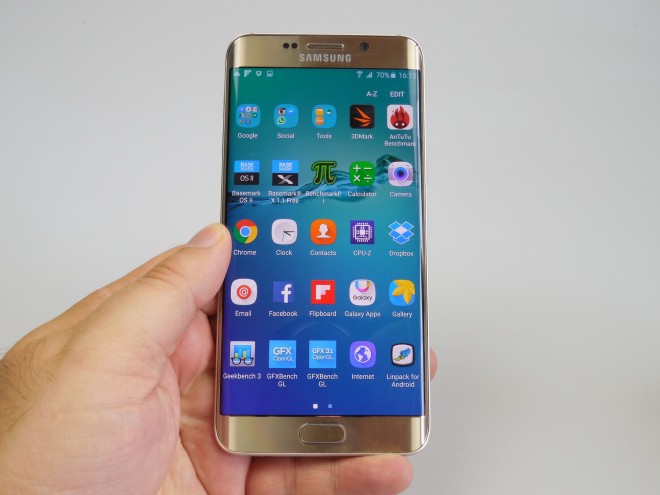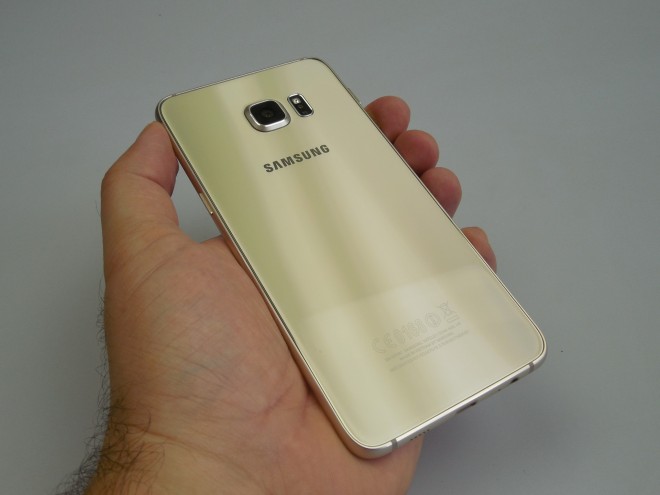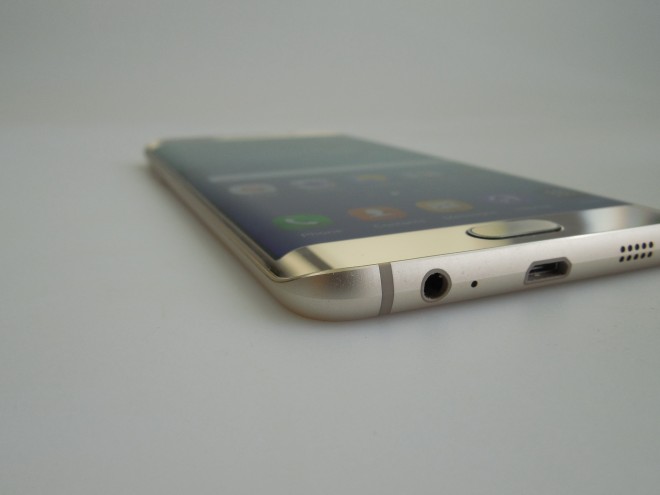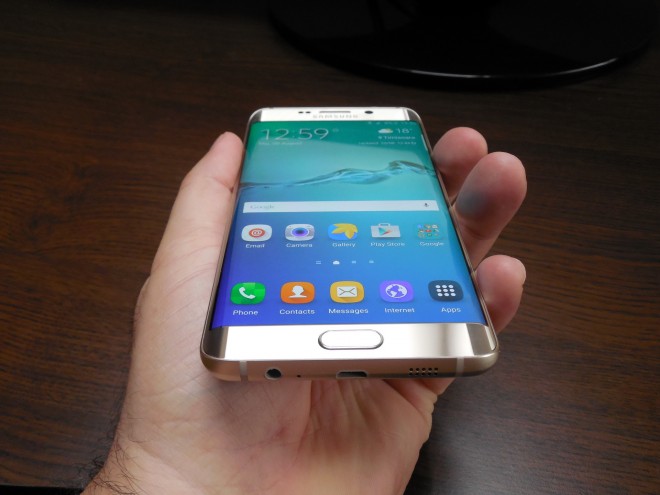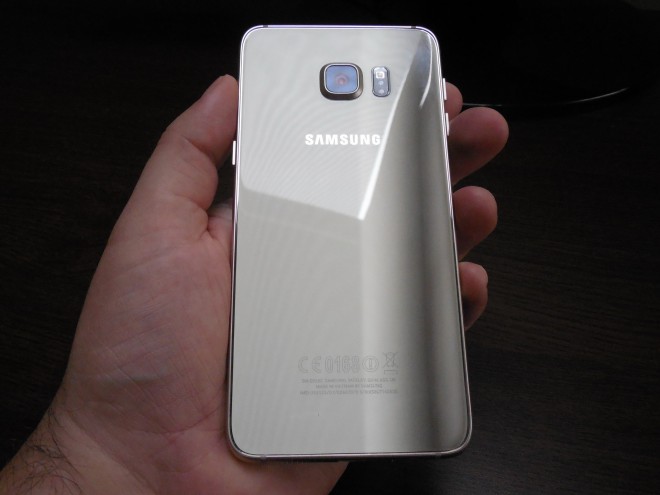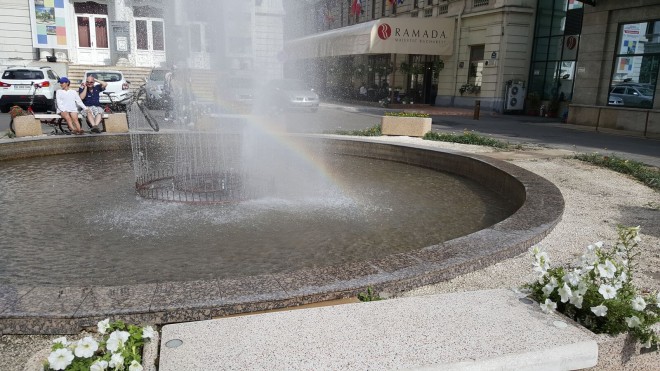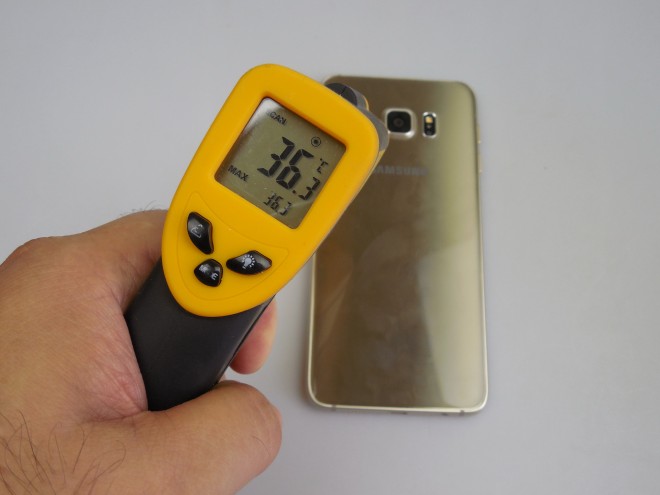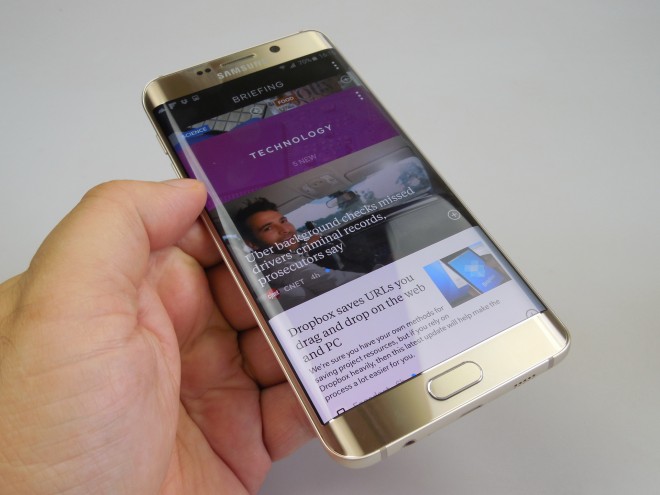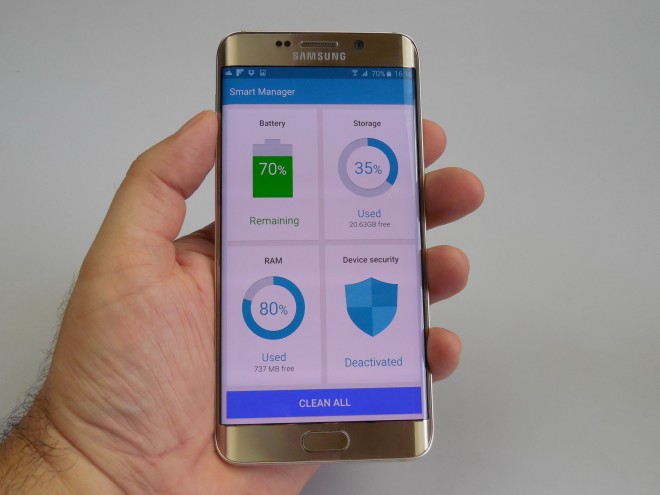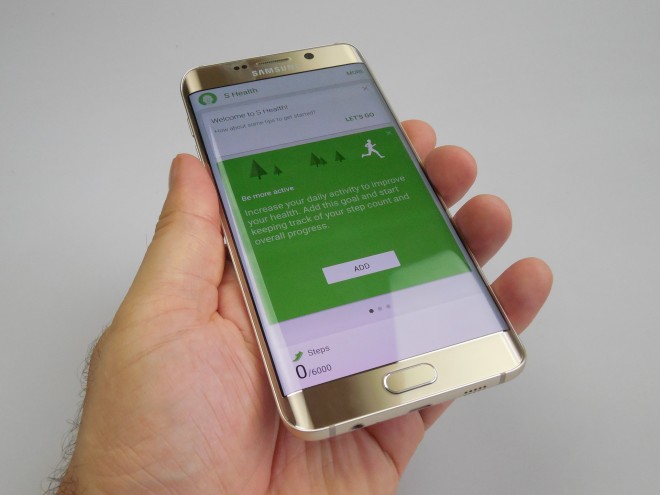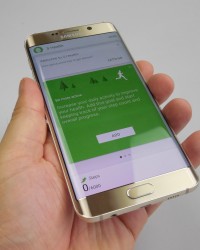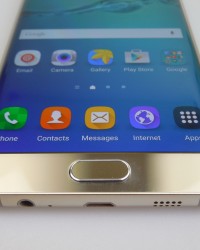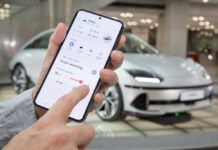Samsung Galaxy S6 Edge+ was announced on August 13th, together with the Galaxy Note 5 and it’s basically a bigger Galaxy S6 Edge with some upgrades. In the following lines you’ll learn all there is to know about this device and all of its quirks. This is a dual curved edge phablet, priced at $1175 in UK (no joking, that’s what their site said), or $815 in USA on AT&T, free of contract.
The design involves a metal frame, sandwiched between 2 glass panels. It measures 6.9 mm in thickness, so it’s slimmer than the 7 mm of the Galaxy S6 Edge, but obviously the device is heavier at 153 grams versus 132 grams (S6 Edge). This feels very light for such a big screen phablet and this model adopts an unibody design, without a removable battery and a microSD card slot.
The quality of construction is impecable and the chassis is solid and comfy. The phone is a bit slippery, but its slightly sharp edge helps with the grip. The back is a fingerprint and grease magnet, especially the gold version, the one we tested. This handset is 12.3 mm longer than the Galaxy S6 Edge and because of the device’s length, it’s quite hard to reach the pulse sensor properly.
One hand usage is OK and the smartphone is made using 7000 Series aluminum, that’s 1.7 times stronger than regular aluminum and also 1.3 more scratch-proof than the same regular aluminum. Galaxy S6 Edge+ comes in gold, black, white or silver and upfront we find the earpiece, sensors, front camera, Home button with fingerprint scanner, notification LED, 2 capacitive buttons and gently curved edges.
At the back there’s the slightly protruding camera, flash and pulse sensor, while at the top there’s a nano SIM card slot and microphone. The bottom includes the speaker, microUSB 2.0 port, microphone and audio jack, but sadly they’re not aesthetically aligned, on a horizontal axis. The left side features slim volume buttons, with good feedback, while the right side includes a Power button, that’s also slim and small, plus comfy.
Overall, this is an elegant and stylish smartphone, with a solid build and it’s the most beautiful Android phone that money can buy right now. I found it hard to believe that the Galaxy S6 Edge could be topped, but it has been, by this model. On the hardware side, we’ve got a 5.7 inch display, a Super AMOLED Quad HD unit, while inside the handset there’s an octa core Exynos 7420 processor, a 64 bit 14 nm chipset that includes 4 cores clocked at 2.1 GHz and 4 cores clocked at 1.5 GHz.
Galaxy S6 Edge+ brings 4 GB of LPDDR4 RAM, 32 or 64 GB of storage, a 16 megapixel main camera and a front 5 MP shooter. On the connectivity front, there’s LTE Category 6 or 9, depending on the country, WiFi 802.11 a/b/g/n/ac, MIMO, Bluetooth 4.2 LE, ANT+, NFC, GPS and Glonass. Finally, the sensors list is rich and includes: accelerometer, proximity sensor, RGB light sensor, geomagnetic sensor, gyroscope, fingerprint sensor, barometer, hall sensor and heart rate sensor.
The battery of the phablet is a 3000 mAh unit (Li-Ion), an upgrade from the Galaxy S6 Edge’s 2600 mAh power source. On paper this battery offers 28 hours of talk time or 14 days of standby. In our test, that involves HD video playback in a loop, with WiFi on and brightness at 50%, we achieved 11 hours and 9 minutes, which is great. We beat the Galaxy S6 Edge and its 10 hours and 47 minutes, as well as the Galaxy S5 and its 11 hours and 4 minutes. The S6 was also beaten, at 9 hours and 49 minutes.
Still, we scored below the iPhone 6 Plus (12 hours) and Allview P6 Energy (12 hours and 9 minutes). The results remain impressive and the same can be said about the PCMark battery test, that showed us 7 hours and 52 minutes of simulated continuous usage. We beat the Galaxy S6 Edge and its 6 hours and 41 minutes of the Galaxy S6 and its 7 hours and 6 minus, plus the Allview X2 Soul Pro and its 7 hours and 23 minutes.
Still, we scored below the Allview P6 Energy and its 11 hours and 24 minutes of PCMark time. Samsung also announced a new type of wireless charging for this model, that only needs 2 hours to juice up. Wired charging should take on paper at least 1 hour and 30 minutes, but surprise, we only needed one hour and 5 minutes, which is a fantastic result, making this the fastest charging phone on the market.
It even beats the excellent Galaxy S6, that charged in one hour and 10 minutes, plus it beats the OnePlus One and its 1 hour and 15 minutes, as well as the Galaxy S6 Edge and its one hour and 25 minutes. Overall, the battery is great and we’ve also got the usual Power Saving features, like Power Save, that limits CPU power, brightness, vibration and frame rate.
Then there’s Ultra Power Saving, that makes the screen grayscale and only offers access to the basic apps and leaves connectivity options off. Now we move on to the acoustics, that include the typical Samsung player with Material Design influences. There’s also the usual SoundAlive EQ, that offers options like Normal, Pop, Rock and Custom with 7 channels to tweak.
Then there are options like 3D, Bass, Clarity and Concert Hall, as well as Adapt Sound, that tweaks the experience to each pair of headphones. Samsung included some headphone-only options, too, like UHQ Upscaler, used to increase the resolution of songs, Sound Alive+, that creates rich surround and Tube Amp. SoundAlive finally offers a bass and treble knob, plus an instrument and vocal knob, so you can choose which part of a song to augment.
Settings also include Play speed and Smart Volume. The actual listening experience involves a loud volume and very good bass, as well as a total lack of distortion. This speaker can cover discussions in a loud chatter room and guitar feels rich, while the voices feel warm. Headphones bundled with the phone are comfy and include rubber plugs, that allow them to sit nicely and deep within the ear.
They’re the exact same pair as the one bundled with the Galaxy S6 Edge and Galaxy S6, by the way. The headphones have a long body and long remote, as well as a tangle-free wire. Their listening experience also involves a loud and clear volume, good bass, crisp sound, but I’ve heard louder, if I’m being totally honest. Noise isolation is probably this pair’s best attribute.
There’s no FM radio in the mix here and when we used our decibelmeter to measure the volume, we reached a value of 85.5 dBA, which beats the Galaxy S6 Edge only slightly, since that one scores 85.3 dBA. We also beat the iPhone 6 Plus and its 83.8 dBA, plus the LG G Flex 2 and its 82.9 dBA. Still, we scored lower than the LG AKA, with its 86.9 dBA, or lower than the HTC One M9 and its 86.9 dBA, plus the Galaxy Note 4 and its 89.5 dBA.
In spite of all those measurements, I have to highlight that the speaker sounds very loud in real life. Galaxy S6 edge Plus packs a 5.7 inch Super AMOLED screen, with a 2560 x 1440 pixel resolution and 518 PPI density. This is a dual curved display and Samsung offers here a very simple and minimalistic video player. You can set up subs and play speed, change aspect and use the already standard pop up play, as well as pinch and zoom.
The viewing experience brought us vivid colors (not oversaturated), high brightness, crisp images and wide view angles. Contrast is excellent and sunlight behaviour too, plus the blacks are deep. This screen uses a Pentile Matrix setup and when we used the luxmeter on it, we reached 546 LUX inside and 852 LUX outside with the Auto mode on (brightness slider) and the sensor exposed to the August sun.
On a very sunny day, the result could be even higher. Still, the champion remains the Galaxy S6 Edge, with its 933 LUX. Meanwhile, we beat models like the Lumia 640 XL LTE and its 769 LUX, as well as the Galaxy Note 4 and its 682 LUX. This remains a very, very bright display. Special screen settings include font, one hand use, Smart Stay, Screen Mode (Adaptive Display, AMOLED Cinema that increases saturation, as well as AMOLED Photo and Basic, that offer undersaturation).
We’re done with the excellent screen and now let’s talk about the camera. At the back rests a 16 megapixel unit, with OIS and F/1.9 aperture, while upfront there’s a 5 MP shooter with F/1.9 aperture and overall, these two cameras should be on par with the Galaxy S6 and Galaxy S6 Edge cameras. The sensor of the Galaxy S6 Edge+ measures 1/2.6 inches and generates shots with 1.1 micron pixels.
The camera can be triggered by a quick double press of the Home button and the activation of the cam is very, very fast. Smart OIS is also here, as well as something called VDIS. The latter is Video Digital Image Stabilization and it’s available for both cameras. Samsung also offers auto real time HDR here. The UI is pretty much the same with the one we got on the Galaxy S6 and Galaxy S6 Edge, minimalistic, transparent and featuring lots of white text.
On the left side there are the Effects, each of them with two sliders and even more downloadable effects available via a shortcut. HDR can be set to On/OFF/Auto and there’s also a Timer, resolution (16 megapixels in 16:9, 12 MP in 4:3 and 8.9 MP in 1:1) and then come the Settings. Here we can set up the video capture resolution (UHD, QHD, Full HD 60 FPS, Full HD 30 FPS and less). Tracking autofocus, video stabilization, grid, location, quick launch, voice control, save as RAW are all options included here.
On the right side of the UI we find the main capture modes, including Pro, Selective Focus, Panorama, Video Collage (4 clips 6 seconds long each, integrated within a fourway split screen), Live Broad Cast (broadcast live on YouTube), Slow Mo, Fast Motion, Virtual Shot (3D capture of a subject by rotating around it in semi circle), plus of course more downloadable modes (Sports, Sound and Shot, Food and GIF).
The Pro mode is the money shot here, with extra options like Metering (Centre weighted, Matrix, Spot), Exposure, Shutter (from 1/24.000 seconds to 10 seconds), ISO (up to 800), white balance (with Kelvin slider included) and Focus (macro, landscape and everything in between). By the way, if you want a comparison of the shutter options, the LG G4 offered from 1/6000 seconds to 30 seconds.
Then there are the tones, each of them customizable in a certain setup, that can be saved, allowing you to alter options like Color temperature, Tint, Contrast, Saturation, Highlight and Shadows. Then you can save your custom setup and use it later on. The front camera menu is also analyzed in the video review and you can take selfies by putting your finger on the pulse sensor now.
Gestures like waving your hand are also supported. There’s a Beauty option, that slims your face, corrects its shape, changes skin tome and enlarges eyes. Quad HD video capture is available with this 5 MP shooter and even video digital stabilization. Finally, you can take wide 120 degree selfies and interval shots, with 4 pics that have 2 seconds in between.
The actual photo taking experience includes 8X zoom, a fluid zoom that is and very fast focus is provided as well. There’s an exposure slider that appears once you tap on the screen. If you keep the screen pressed, you will trigger the AF/AE lock mechanism. Picture taking is very fast and burst shot is also available (also fast). Now, as far as the gallery goes, we took the pictures at the end of August, in sunny/cloudy conditions.
We also did some crisp indoor shots and I have to say that some pictures taken in the Auto mode are a bit white-ish. HDR tends to burn some pictures and overall I’d say we got realistic colors in all the shots. Panorama is excellent, fast taken and crisp, offering a resolution of 16.256 x 1632 pixels, as well as good details. We have some cool looking closeups of a metal ornament, plus 4 shots of a statue’s face. The full day time gallery is here.
The first one is a regular shot, the second HDR, the third one looks excellent with flash and the fourth was taken using the shutter speed option. Galaxy S6 Edge+ is able to take clear, crisp, bright and well balanced photos, but the exposure in the Auto mode is not always top notch. It feels below the LG G4 and Galaxy S6 Edge, but it could just be the fault of our test unit.
Details are excellent in landscape shots and the closeups of flowers are stunning. Blues look particularly good and we even caught a rainbow in a shot. Selective Focus also triggers some nice refocused shots and photographs of text and posters look excellent too. The texture of the statues in the gallery is great too and when we zoom into that statue of squares, quality wasn’t lost at 3X and barely suffered at 6X.
Subjects in motion are also caught OK with no blurring. Selfies weren’t very clear, which I found to be strange. I’ve seen better on the Galaxy S6, to be honest. Indoors we have some shots of smoothies, with excellent texture and colors. Overall the quality is good, but I feel (gut feeling) that the quality isn’t superior to the one of the Galaxy S6 Edge or the LG G4. Keep in mind that most of the shots we took were in Auto mode and when you switch to Pro and actually find the ideal setup, the camera has no rival.
Closeups are indeed perfect, though. Low light capture (gallery here) involves a series of pictures taken in full night time, offering good brightness, good clarity, but also a flash that tends to burn pictures. If you play with the shutter speed you will increase the brightness of the image, but you are required to have very steady hands or use a tripod. Colors look good at night and exposure is also pretty good. I’d say we’re on par with the LG G4, iPhone 6 Plus and other big contenders.
Street light handling is also OK and I’d say that low light capture on the Galaxy S6 Edge+ is superior to what we had on the Galaxy S6. We also tested video capture, available in Full HD 60 FPS, Full HD 30 FPS, 4K and Quad HD. There’s also slow motion, fast motion and HDR video capture. The first video we captured was a Full HD 30 FPS one, with 17 Mbps bit rate and great quality, as well as good stabilization.
Colors are realistic and focus is good. The second video is a Full HD 60 FPS one, with 29 Mbps bitrate, it looks crisp and it’s a bit dark, plus cinematic. There’s also a bit of details loss during zoom. The third video is a 4K one, with 48 Mbps bitrate and frankly speaking, this is the best video I’ve ever filmed with a smartphone… EVER. A problem was the audio hissing, that we couldn’t explain.
The fourth video is a Full HD 30 FPS one, this time with video stabilization on and stabilization was excellent, image was crisp and colors were vivid. The fifth video is a HDR one with stabilization on as well, a clean and clear image, but also with that hissing audio background. We also demoed the slow motion and fast motion filming, both tweakable for certain portions of the videos.
Night time filming is basically mediocre and grainy, with the second video suffering from focus loss, but starting off crisply. The third low light video has OK quality and good lighting. We draw a line here and say that the Galaxy S6 Edge+ films excellently during the day, on par with champions like iPhone 6 Plus and LG G Flex 2, beating the LG G4 in the process.
At night, the video capture is inferior to the champions, but not far from the Galaxy S6 and Galaxy S6 Edge. Now that we’re done with the camera, you should know that you can also do photo editing, by using options like Auto Adjust, Crop, Drawing, Effects, Tone, Collage or Animate. Video editing is available too, with options like trimming, effects and background music.
After playing 15 minutes of the game Riptide GP2, we reached 36.3 degrees Celsius, so there’s no overheating here. The web browser is fast and there’s a comfy keyboard in the mix, well spaced and offering a numeric row and handy clipboard. The phone calling section brings a very loud experience, clear sound, good signal and perfect noise canceling. Videocalling is available via a shortcut and we also get speed dial and smart dial.
Now off to the benchmarks. We compared the Galaxy S6 Edge+ to the Galaxy S6 Edge, HTC One M9 and LG G4, as well as the iPhone 6 Plus. This is a battle of the Exynos 7420, Exynos 7420 again, Snapdragon 810, Snapdragon 808 and Apple A8. Here are the results:
Galaxy S6 Edge+ wins 5 out of the 11 tests because of the Galaxy S6 Edge, that beats it in some benchmarks. Without the S6 Edge we win in 8 out of 11 tests. Performance is great, there’s no hint of lag and games with 3D graphics like Riptide GP2 run like a charm. The OS is Android 5.1.1 Lollipop here and the UI is the latest version of TouchWiz, now more mature, minimalistic, flat and smartly designed. The software experience is 90% the one of the Galaxy S6 Edge.
Material Design is also present here, in various forms. The multitasking is done via the carousel view and it includes a small dual rectangle sign on some of the multitasked apps, showing that they can be part of a split screen setup. You can also trigger that by keeping pressed the Recents button. Split screen works like a charm and offers the ability to drag pics and text between windows.
Flipboard is still here, in the leftmost homescreen and it’s totally optional. If you keep the homescreen pressed, you will trigger options like Widgets, Wallpapers, Themes, Screen Grid. The dropdown area includes Quick Settings, brightness slider, S Finder, Quick Connect and notifications. Settings have a shortcut section at the top, with favourite settings editable in that area.
Then we get to the options related to the curved screen edges. You can tweak the edge lighting and there’s also a quick reply option available. A piece of novelty compared to the Galaxy S6 Edge is the Apps Edge, that shows a list of apps, now easily accessible, with a swipe from the curved edge to the center. Up until now the curved edge showed only contacts and lit up in a certain color once you got an email or phone call or text from that contact.
The info stream is still here, showing up in standby mode, on the curved edge, after being swiped for a few times. That one shows news from Yahoo, some notifications and the weather. The edge keeps all the functionality of the S6 Edge, but only adds the app list section. As with the Edge, once you put the device with the screen on a flat surface, you can see the color coded notification radiating from the sides once you get called or messaged.
Back to the Settings, there’s Direct Call, Smart Alert, Mute and Palm Swipe to capture screenshot, the typical gestures. We also tested the fingerprint scanner, with excellent speed and fast setup. Device security also involves Knox, for an extra layer of safety and file protection. The preinstalled apps list is reasonable here, with no bloatware and the ability to uninstall most apps.
You also get a bonus 100 GB in Onedrive storage. So, the preinstalled apps are Google, Voice Search, Gmail, Drive, Play Music, Hangouts, Photos, Instagram, Messenger, Whatsapp, Calculator, Chrome, Email, Facebook, Flipboard, Galaxy Apps, Maps, Memo, Message, OneDrive, Paper Garden, Play Store, S Planner, S Voice, S Health, Side Sync, Smart manager, Telly and YouTube.
Paper Garden is a magazine app, S Planner now shows weather and birthdays, while S Health is minimalistic and lets you monitor pulse, stress level and O2 saturation, with pretty precise results. It also features a pedometer and the fitness features we’ve already seen on the Galaxy S6. S Voice has evolved a lot, with a less robotic voice, increased speed, more precise results and improved interaction.
Side Sync mirrors the content on your handset to another device and Smart Manager cleans your RAM and storage. Overall, the UI felt fluid and there was no lag and bloatware. Galaxy Apps also brings some RSS apps that show content on your curved edges. Now it’s time for the verdict.
Here are the Pros:
beautiful design
elegant phone
good battery
fantastic charging time
great acoustics
bright screen
useful shutter option
great quality filming
excellent low light capture
lots of camera options
good benchmarks
fast and fluid UI
no bloatware
And the Cons:
edge feels gimmicky function-wise
some auto mode shots are a bit too white
hissing audio when filming
colors a bit cold
back gets smudged easily
night time video capture is unimpressive
selfie doesn’t impress
In the end it all depends on your taste and I prefer the Galaxy S6 Edge, but more of a good thing is still a very good thing. That doesn’t mean this isn’t a fantastic design, close to being in pole position already for the “Phone of the Year Award”. We give this smartphone a 9.8 out of 10 for design, a 9.5 for hardware and a 9.7 out of 10 for OS and UI. The final grade is 9.66 out of 10 and while this is an amazing phone, the curved edges are still underused and it’s a pity you only get to use only one at a time.
The device has a perfect battery, display, audio and camera, plus a fantastic design, so that’s what you should remember.

